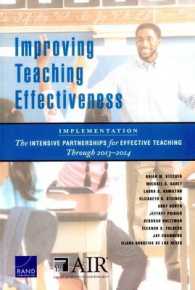Full Description
In Challenging the Status Quo: Diversity, Democracy, and Equality in the 21st Century, David G. Embrick, Sharon M. Collins, and Michelle Dodson have compiled the latest ideas and scholarship in the area of diversity and inclusion. The contributors in this edited book offer critical analyses on many aspects of diversity as it pertains to institutional policies, practices, discourse, and beliefs. The book is broken down into 19 chapters over 7 sections that cover: policies and politics; pedagogy and higher education; STEM; religion; communities; complex organizations; and discourse and identity. Collectively, these chapters contribute to answering three main questions: 1) what, ultimately, does diversity mean; 2) what are the various mechanisms by which institutions understand and use diversity; and 3) and why is it important for us to rethink diversity?
Contributors: Sharla Alegria, Joyce M. Bell, Sharon M. Collins, Ellen Berrey, Enobong Hannah Branch, Meghan A. Burke, Tiffany Davis, Michele C. Deramo, Michelle Dodson, David G. Embrick, Edward Orozco Flores, Emma González-Lesser, Bianca Gonzalez-Sobrino, Matthew W. Hughey, Paul R. Ketchum, Megan Klein, Michael Kreiter, Marie des Neiges Léonard, Wendy Leo Moore, Shan Mukhtar, Antonia Randolph, Victor Erik Ray, Arthur Scarritt, Laurie Cooper Stoll.
Contents
Acknowledgments
Map and Tables
Notes on Contributors
Part 1: Introduction
1Diversity: Good for Maintaining the Status Quo, Not So Much for Real Progressive Change
David G. Embrick
Part 2: Policy, Politics, and Practice
2Diversity and Affirmative Action: A Closer Look at Concepts and Goals
Sharon M. Collins
3Is Diversity Racial Justice? Affirmative Action in Admissions and the Promises and Perils of Law
Ellen Berrey
4Disfavored Subjects: How Liberalist Diversity Fails Racial Equity in Higher Education
Joyce M. Bell and Wendy Leo Moore
5"Boatloads of Money" in the Great Equalizer: How Diversity Furthers Inequality at the Neoliberal University
Michael Kreiter and Arthur Scarritt
Part 3: Pedagogy and Transformation in Higher Education
6Teaching in Black and White: Reflections of Teaching the Social Construction of Race
Tiffany Davis, Wendy Leo Moore and Joyce M. Bell
7"Formed, Transformed, Destroyed, and Re-formed": Diversity Formation at a Majority-Minority University
Shan Mukhtar
Part 4: Diversity and stem
8Diversity in stem: How Gendered Structures Affect Women's Participation in Science
Marie des Neiges Léonard
9Equal Opportunity in Science: Diversity as an Economic and Social Justice Imperative
Enobong Hannah Branch and Sharla Alegria
Part 5: Diversity and Communities
10Diversity in the Church: A Comparative Analysis of Multiracial, White, and Black Congregations
Michelle S. Dodson
11"Not in My Backyard": How Abstract Liberalism and Colorblind Diversity Undermines Racial Justice
Laurie Cooper Stoll and Megan Klein
12Sympathetic Racism: Color-Blind Discourse's Liberal Flair in Three Diverse Communities
Meghan A. Burke
Part 6: Diversity and Complex Organizations
13When a Lack of Diversity Matters: How Juvenile Justice Professionals See Non-White Juveniles
Paul R. Ketchum
14Critical Diversity in the U.S. Military: From Diversity to Racialized Organizations
Victor Erik Ray
15Undermining Prisoner Re-entry Initiatives: Neoliberalism, Race and Profits
Edward Orozco Flores
Part 7: Meanings, Discourse, and Identity
16On-Demand Diversity? The Meanings of Racial Diversity in Netflix Productions
Bianca Gonzalez-Sobrino, Emma González-Lesser and Matthew W. Hughey
17From Capital to Credit: On the Contingent Value of Difference within Diversity Discourse
Antonia Randolph
18The Spectacle of Volunteerism: Aid, Africa, and the Western Helper
Michele C. Deramo
Index






